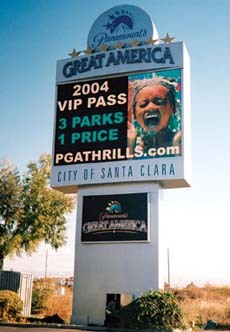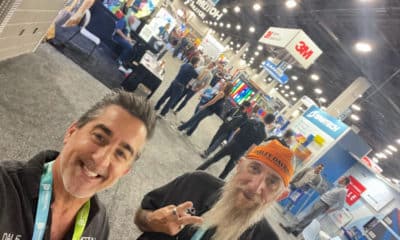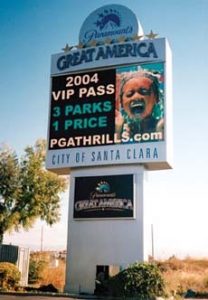In 1978, when I began my career as a peddler of electronic-message-center (EMC) signs, I was a young lad of 25. I spent most of my time prospecting for sales and explaining the then-nebulous advertising merits of a programmable sign. I worked in the Midwest, which had few such displays, and those were predominately the single-line, 18- to 24-in., 30W lamp variety. A proposed multi-line display was a very big deal. Today, 26 years later, while most in my chronological set bemoan their graying hair and expanding waistlines, I’m having the time of my life — professionally speaking. The tiny closet business in which I’ve toiled for almost three decades has emerged as a burgeoning industry.
Historically, electronic-sign-industry growth was limited by customer acceptance. Few industry segments relished the image of flashing-lamp, text messages. For those few who recognized the advertising benefits, many were limited by restrictive zoning. Others protested the maintenance issues and high energy costs.
Today, the technology can portray virtually any visual impression in any size, shape, color, brightness, presentation format and schedule. The display media are more functionally sound, more energy efficient and very low maintenance. This medium is more passive than intrusive, which has spawned a slowly evolving acceptance by the same governments that fought to restrict the older technologies.
Currently LED displays now deliver adequate brightness and resolution. Newer technologies, such as organic LEDs (OLEDs), are just a few years away from signage viability. Liquid crystal displays (LCD) are emerging in outdoor-brightness, television sized formats. The functional, viable technology of the future is here, and it’s affordable and available from various sources.
The sign seller’s role has come full circle back to the media’s creative aspect. Today, when a sign salesperson proposes programmable-display technology as advertising, his arguments have "teeth." Few dispute the impact of a programmable sign’s impact on a busy thoroughfare as an effective advertising medium.
Now, the important discussions concern how we use this medium. In-depth studies and evaluations continue to examine the most effective uses of the new technologies. $image1
Advertisement
Outdoor advertising
The Outdoor Advertising Assn. of America (OAAA) held an operations seminar in Nashville in January and an executive seminar in Chicago in May. This influential industry body has formed a committee to study the most effective use of the new "digital media."
In addition to its own conventions, digital-committee members attended the ISA Sign Expo in Las Vegas in April to specifically evaluate EMC products and discuss a more standardized approach to conventional billboard replacement.
Among major public-media companies, Lamar Advertising Co. (Baton Rouge, LA) started the push toward LED digital displays with its placement of four LED "SmartBoard" displays, produced by |2241| (Brookings, SD) in 2003 (see ST, January 2003, page 38, plus cover photo). Since then, the SmartBoard program has expanded to more than 20 displays, produced by Daktronics and YESCO Electronics, installed in various markets.Daktronics Inc.
Clear Channel Outdoor, which recognized the Lamar SmartBoard’s success, prompted an in-depth study of electronic digital media with Lamar’s complete cooperation. Subsequently, Clear Channel deployed seven, full-color, full-sized bulletin displays in Cleveland, in May 2005. In order to more effectively sell the advertising, Clear Channel plans to utilize this test market to provide "proof of performance" for its clients, and optimize networking and sequencing the advertising.
Smaller outdoor firms have also made significant inroads as well. LED billboards are springing up in markets ranging from Pittsburgh to Cookeville, TN.
Advertisement
Shopping malls
For decades, shopping malls have been considered fodder for the programmable sign salesperson. Unfortunately, although logic endorses a programmable ad placed in front of a giant retail complex, their limitations restricted sales.
However, the current, state-of-the-art technology makes those limitations moot. Consequently, shopping-center developers of all sizes are beginning to embrace the technology. Of particular note, Simon Property Group, the world’s largest mall retailer, is aggressively pursuing electronic-digital-sign (EDS) opportunities both inside and outside their malls. Because mall stores offer such a wide variety of products and services, third-party advertising opportunities with product manufacturers fit within the on-premise requirement of most municipal codes.
Chain retail/fast food
Numerous chain stores and fast-food entities, which historically rejected on-premise, programmable media in favor of national media campaigns, are now embracing displays’ impact as point-of-sale media for individual stores. Walgreens, CVS, McDonald’s, KFC and others have made significant display deployments.
Display conferences
Advertisement
As our industry comes of age, every-one wonders how best to utilize the product. This is very healthy, as more and more creative minds focus on effective technology use.
An April, New York City conference, the Digital Signage Advertising Summit, brought together various display providers, current display users, programmers, creative people and prospective display-technology users. The conference studied various aspects of the new medium and their most effective utilization.
If you missed it, similiar gatherings will be forthcoming. I highly recommend these opportunities to get up-to-speed on the latest technological innovations and their uses.
One future conference, with which I will be involved, is the Power Signs 2005 Conference to be held in Las Vegas, October 17-19, hosted by Intertech Corp. This conference will bring together technology suppliers and users worldwide. It will explore emerging technologies as well as the current LED systems. Various outdoor-advertising and retail applications will be targeted, plus numerous other uses.
Las Vegas offers a unique locale, given its density of programmable-sign technologies. Various displays may be viewed in their native environments, which allows firsthand examination of both signs’ use and their condition as they age.
During the conference, I’ll conduct a bus tour of Las Vegas’ notable signs. Each sign’s manufacturer, technology and date of installation will be noted. For information on this conference, e-mail me at klausmeier@earthlink.net or Chuck Spear at CSpear@IntertechUSA.com.
With the programmable-sign industry’s evolution, I urge all sign suppliers to consider their place as potential suppliers of such products. Many sign companies have, for years, shied from the technology
in favor of more traditional, static signs. As the years pass and programmable technologies become more user-friendly, it’s worth re-evaluating the technology’s potential in your sales arsenal.
In 2000, I predicted to Mike Young, president of YESCO, that, in the near future, most signs would have a programmable component. I think he questioned my logic at the time, but I doubt that he does today.


 Photo Gallery2 weeks ago
Photo Gallery2 weeks ago
 Paula Fargo2 weeks ago
Paula Fargo2 weeks ago
 Real Deal1 week ago
Real Deal1 week ago
 Photo Gallery2 weeks ago
Photo Gallery2 weeks ago
 Projects1 week ago
Projects1 week ago
 Business Management1 week ago
Business Management1 week ago
 News20 hours ago
News20 hours ago
 Dale Salamacha4 days ago
Dale Salamacha4 days ago
















